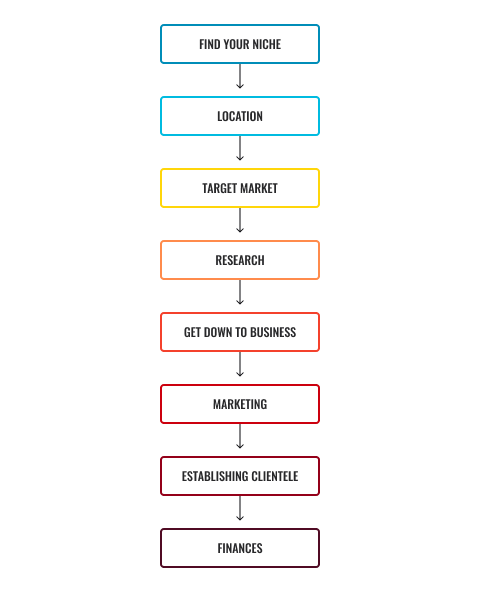In this topic, we focus on the processes taken to setting up your very own business. You will explore:
- A step-by-step guide to setting up a successful fitness business
- Discuss how the SMARTER analysis is applied to setting business goals.
Terminology and vocabulary reference guide
As an allied health professional, you need to be familiar with terms associated with basic exercise principles and use the terms correctly (and confidently) with clients, your colleagues, and other allied health professionals. You will be introduced to many terms and definitions. Add any unfamiliar terms to your own vocabulary reference guide.
Activities
There is an automated quiz at the end of the topic. This is not part of your assessment but will provide practical experience that will help you in your work and help you prepare for your formal assessment.

When working in the fitness industry, there may be a time where opening up your own business is something that may be of interest to you.
Different avenues can be taken when looking to start a business within the fitness industry, these will likely depend upon which avenue you wish to pursue, for example, self-employed versus independent contractor or an employee or if you wish to focus on group instruction or personal training. The thought can be exciting, thrilling but also daunting as you ask yourself where to begin?
The following steps provide a step-by-step guide in getting your name out there.

-
Find your niche
Choosing a niche that you will focus on and become an expert in. Many trainers enter the industry with plans to take on everything, thinking this will maximise their business. Truth is, this spreads the trainer thin, typically leading to burning out and instead of mastering one skill. A key step in establishing yourself is asking yourself, “what do I want to do? Who do I want to help? By focusing on one specialty, you are able to increase your knowledge, experience and skills to build your chosen customer base. -
Location
Identifying where your chosen business will be located is an important part of starting a business. Your location will either determine, or be determined by your clientele, your price point, and the entire theme of your business. For example, if your business is to be based in an area of low socio-economic standing, you would not expect to attract many clients with a high price point. Alternatively, if your business is set within the inner city, it is highly likely your clientele will be individuals who work full time and may need to train during lunch or outside work hours, therefore being situated near office complexes would be ideal to help cater to their needs. -
Target market
This step could be combined with the previous step, determining your location, as here you would be focusing on identifying your target market- who are you looking to provide your service to? Focusing on your clientele, choosing your target audience will have a large impact on the direction of the business. Once the chosen market has been identified you can begin to think about the design and needs of your marketing materials in order to attract the clients you are looking to work with. -
Research
Once you have chosen your target audience and location it is important to conduct research on whether there are businesses that provide similar services and who may be in direct competition. This step is key and one which you should not rush, the more time you spend conducting research, the more information you have to assist you in making smart business decisions. Consider this a ‘risk-management’ step, with good information comes fewer surprises and pitfalls. You should aim to establish details such as:- Knowing who your competition is and can become in the future
- How have other trainers in your area received clients?
- Establishing and ensuring the price range is reasonable for the location and target audience
- Determining if the type of service you are intending to provide is of need in the area you are researching
- Establishing what is your unique selling point (USP) why should clients select you over others in the area- what is in it for them?
-
Let’s get down to business
Now that you have established the fun details, it is now time to dive into completing the paperwork that goes along with starting up a business. Depending on whether you would like to work as an independent contractor, or self-employed you will need to consider the following:- The name of the business
- The budget
- A price list
- Equipment (what do you need, will you buy it, rent it, share it, use a gyms equipment?)
- A business bank account
- The business structure
- Registrations, insurance, licenses or permits that are relevant to your business structure.
-
Marketing
Once steps 1-5 have been completed; the next exciting stage is marketing. Until you start telling people you exist, no one will be able to sign up for your services. You can then begin to consider, how do you plan on getting your name out there? What is the most effective method of marketing for your target group? These are questions that need to be answered before marketing is undertaken. Social media has become extremely popular over the years and effective in getting a message across however, this would all depend on the chosen target group. This method may not be effective if your business focuses on supporting the elderly as they may not be familiar with social networks including Instagram and Facebook. It is important to understand your target market and develop marketing materials that will make an impact. By monitoring what has worked and where your clients are coming from will help you to understand what marketing method is been effective and what may be useful for you. -
Establishing a clientele
Well done, now it is time to start signing up clients! You should aim to have this process running smooth for both parties. Firstly, procedures need to be put in place. These will need to include client sign-ups, induction forms, screening forms, program design templates, client databases, and cancellation processes. By having effectively run procedures clients will enjoy the process which will ultimately help them gain trust in the business. Procedures that need to be considered include:- Initial and on-going consultations: how do you plan to document these? What will be your privacy policy to guarantee a client’s information is handle appropriately (and legally)?
- Contracts: What length of contract are you planning on implementing?
- Cancellation policy: determine what your cancellation policy you wish to instate.
- Injury forms: how do you plan on handling client injury in regards to their training and cancellation policy, what will your process be if your training is the reason for their injury?
- Bank documentation: what information do you need to collect from your clients for receiving payment for services? How will you safeguard this?
- Insurance: what are the insurance requirements for your line of training or your area? Do these insurance applications require any other documentation such as proof of first aid, registration, memberships with other associations?
-
Finances
Tracking your cash flow is important, you will need to have a system in place to keep track of the money coming in and out. This includes payments from clients, refunds, cancellations, expenses etc. These will need to be monitored to ensure the business is successful, it is easy to get excited and overspend, especially when initially setting up your new business. By staying on top your income and expenses will support your understanding of where your business sits in relation to profitability as well as identifying your cash flow through income/expenses. After the completion of these steps, it is time to put all knowledge into action. Have fun and get started!

Setting goals is the first step in turning the invisible into the visible.
Tony Robbins
A key step in ensuring your business becomes successful is setting goals for where you wish to see your business be in the future. These goals should typically be short (within 12 months), medium (12 to 36 months) and long term (36 onwards).
Goals should be designed using the SMARTER principle:

The following are examples of SMARTER business goals:
- To retain 75% of boot camp attendees per block within the first 12 months of set up.
- To start my boot camps in at least 1 location with 2 sessions a week, with 14 clients attending within the first 6 months.
- To increase the number of likes on my Facebook page to 200 by the end of July.
- To finish purchasing weight equipment within the next 3 months to ensure all clients are provided with appropriate training equipment.
- To complete and deliver brochures to at least 200 homes in the first week.
These are considered appropriate smarter business goals as they have specific strategies and time frames that make achieving the goal clear. They also determine whether the goal will be able to be met or not within that timeframe with no ambiguity.
The following are examples of goals which do not follow the SMARTER goal setting process:
- To have 10 hours of paid coaching time signed up and committed to training regularly with me
- To have attended some professional learning around sales and marketing
- To have developed my skills in social media marketing to create a more professional Facebook page and website
- Build connections within our local community of health professionals such as women’s health physio and midwife, who are also passionate about women exercising pre and postnatally
- Create the type of business that provides some freedom in how we choose to structure our time to meet work life balance.
These are considered inappropriate smarter goals as they are vague and do not have set time frames of when these need to be met. They do not provide specific strategies or clear objectives figures to help identify whether the goals will be met or not.
Setting effective SMARTER goals enables you to have a clear outlook in what you wish to achieve and guides you to keep on track and keep your focus whilst working towards making your business dreams come true. Working towards a loose or undefined goal often results in the derailment of desired achievements. A goal without a purpose and a due date is a dream, not a goal.
The following video provides a handy and informative guide as to how use SMART goals for setting up effective marketing campaigns for your business.
In this topic, we focused on the processes taken to setting up your very own business. You explored:
- A step-by-step guide to setting up a successful fitness business
- Discuss how the SMARTER analysis is applied to setting business goals.

